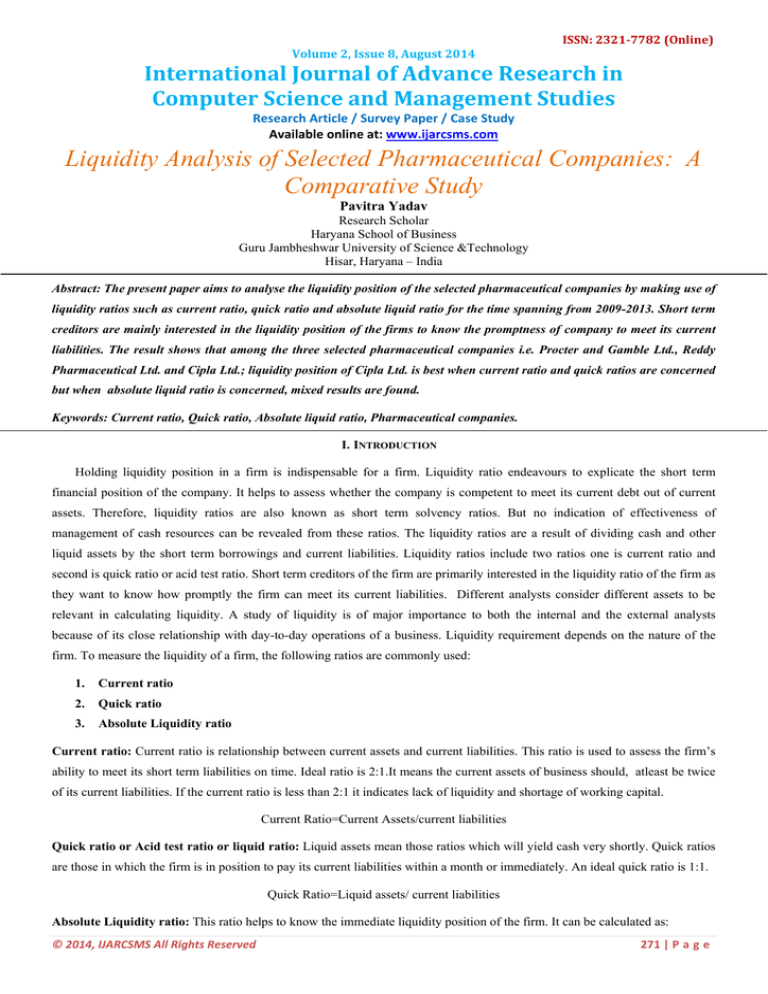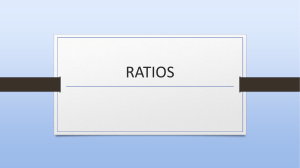
ISSN: 2321­7782 (Online) Volume 2, Issue 8, August 2014 International Journal of Advance Research in Computer Science and Management Studies Research Article / Survey Paper / Case Study Available online at: www.ijarcsms.com
Liquidity Analysis of Selected Pharmaceutical Companies: A
Comparative Study
Pavitra Yadav
Research Scholar
Haryana School of Business
Guru Jambheshwar University of Science &Technology
Hisar, Haryana – India
Abstract: The present paper aims to analyse the liquidity position of the selected pharmaceutical companies by making use of
liquidity ratios such as current ratio, quick ratio and absolute liquid ratio for the time spanning from 2009-2013. Short term
creditors are mainly interested in the liquidity position of the firms to know the promptness of company to meet its current
liabilities. The result shows that among the three selected pharmaceutical companies i.e. Procter and Gamble Ltd., Reddy
Pharmaceutical Ltd. and Cipla Ltd.; liquidity position of Cipla Ltd. is best when current ratio and quick ratios are concerned
but when absolute liquid ratio is concerned, mixed results are found.
Keywords: Current ratio, Quick ratio, Absolute liquid ratio, Pharmaceutical companies.
I. INTRODUCTION
Holding liquidity position in a firm is indispensable for a firm. Liquidity ratio endeavours to explicate the short term
financial position of the company. It helps to assess whether the company is competent to meet its current debt out of current
assets. Therefore, liquidity ratios are also known as short term solvency ratios. But no indication of effectiveness of
management of cash resources can be revealed from these ratios. The liquidity ratios are a result of dividing cash and other
liquid assets by the short term borrowings and current liabilities. Liquidity ratios include two ratios one is current ratio and
second is quick ratio or acid test ratio. Short term creditors of the firm are primarily interested in the liquidity ratio of the firm as
they want to know how promptly the firm can meet its current liabilities. Different analysts consider different assets to be
relevant in calculating liquidity. A study of liquidity is of major importance to both the internal and the external analysts
because of its close relationship with day-to-day operations of a business. Liquidity requirement depends on the nature of the
firm. To measure the liquidity of a firm, the following ratios are commonly used:
1.
Current ratio
2.
Quick ratio
3.
Absolute Liquidity ratio
Current ratio: Current ratio is relationship between current assets and current liabilities. This ratio is used to assess the firm’s
ability to meet its short term liabilities on time. Ideal ratio is 2:1.It means the current assets of business should, atleast be twice
of its current liabilities. If the current ratio is less than 2:1 it indicates lack of liquidity and shortage of working capital.
Current Ratio=Current Assets/current liabilities
Quick ratio or Acid test ratio or liquid ratio: Liquid assets mean those ratios which will yield cash very shortly. Quick ratios
are those in which the firm is in position to pay its current liabilities within a month or immediately. An ideal quick ratio is 1:1.
Quick Ratio=Liquid assets/ current liabilities
Absolute Liquidity ratio: This ratio helps to know the immediate liquidity position of the firm. It can be calculated as:
© 2014, IJARCSMS All Rights Reserved 271 | P a g e Pavitra et al.
International Journal of Advance Research in Computer Science and Management Studies
Volume 2, Issue 8, August 2014 pg. 271-274
Absolute Liquidity ratio= cash & bank balance + short term investments/ current liabilities.
II. REVIEW OF LITERATURE
Hifza Malik(2011) investigated the determinants of profitability in insurance companies of Pakistan and examine effects f firm
specific factor(age ,size, volume of capital, leverage ratio and loss ratio) on profitability proxied by ROA. It includes 35 listed
life and non life insurance companies under the period of 2005-2009 lastly concluded that there is no relationship between
profitability and age of the company and there is significantly positive association between size of company and profitability. It
also shows that volume of capital is significantly and positively related to profitability. Loss ratio and leverage ratio shows
negative but significant relationship with profitability.
Karamjeet and Firew(2011) conducted a study to assess the working capital adequacy and its impact on profitability of firms
using a sample of 449 Indian manufacturing firms and found that there is significant difference in relative solvency level of
firms and firms and firms with adequate working capital.
Rohit and Vipin (2012) investigated on determinants of corporate liquidity in India for a sample of 100 firms in Indian market
over the period 1999-2008. It was found that size of firm has no impact on liquidity.
Dhulia Hirenkumar Kantilal (2012) studied on analysis of gross profit to sales ratio of top ten pharmaceutical companies and
shows that there is significance difference between in the gross profit to sales ratio among different companies under study as
well as different years of each company lastly the researcher concluded that Gross Profit to sales ratio among different
companies and among different years under study is not same.
Sandhar et.al (2013) examined the relationship between liquidity and profitability of selected Indian cement companies using
regression analysis and revealed that current ratio and liquid ratio are negatively associated with return on assets (ROA) , return
on investment (ROI) and cash turnover ratio is negatively associated with ROI and ROA.
Neeraj and Devesh (2013) studied liquidity position and impact on profitability of Tata Steel and steel authority of India. The
study found that liquidity position can be improved with the help of low average collection period and average collection can be
reduce by proper coordination between sale, production and finance department, lastly conclude that study found positive
impact of liquidity position on profitability with the help of various techniques.
Ashok Kumar (2013) studied liquidity position of five leading companies which cover period of 10 years from 2000-2010. It
has been found that the liquidity position of small companies are better as compared to big ones .Lastly, it is concluded that
companies should maintain an ideal current and liquid ratio.
R.Amsaveni & Gomathi (2013) analysed the fundamental analysis of BSE listed FMCG companies for a period 2006-07 to
2011-2012.Researcher has studied economic, industry and company analysis and found that from economic analysis, GNP,
Inflation, Interest rates, Exchange rate foreign exchange reserves, Agricultural Production ,Government Receipts and
expenditure has a positive growth rate during the study period and gross domestic product, gross domestic capital formation
savings and balance of payments has negative growth rate during the study period.
Sarvanan and Abarna (2014) conducted study on liquidity analysis of selected automobile companies in India using Anova
and found that there is significant difference among the absolute liquid ratios of the selected automobile companies.
III. OBJECTIVE OF THE STUDY
To analyse the liquidity position of the selected Pharmaceutical companies.
© 2014, IJARCSMS All Rights Reserved ISSN: 2321‐7782 (Online) 272 | P a g e Pavitra et al.
International Journal of Advance Research in Computer Science and Management Studies
Volume 2, Issue 8, August 2014 pg. 271-274
IV. RESEARCH DESIGN
Source of Data: The study is based mainly on secondary data relating to the study was obtained from the annual reports of the
companies. In addition, Magazines, Journals were also referred for finalising the methodology for the study.
Period of Study: The study covers a period of 5 years covering a period from 2009-2010 to 2012-2013. It is also decided by
taking into consideration of the availability of data.
Sample of the Study: The researcher have selected only 3 companies irrespective of their size to see to what extent they are
profitable financially strength and liquid position. The selected companies are Procter and Gamble Ltd., Cipla Ltd. and Dr.
Reddy Laboratories Ltd.
V. FRAMEWORK OF ANALYSIS
The Secondary data was collected from annual reports of companies. Statistical tools are applied to analyse the financial
performance with the help of ratios. Calculations were made to test the liquidity performance of selected companies of
Pharmaceutical sector.
Analysis and Interpretation
Table 1 given below presents the current ratio of the selected pharmaceutical companies i.e. Procter and Gamble
Ltd.,
Reddy Pharmaceutical Ltd. and Cipla Ltd. for the period 2009 to 2013.
Year
2009
2010
2011
2012
2013
Table-1: Current ratio
Procter and Gamble Reddy
Pharmaceuticals
Ltd.
Ltd.
0.807
2.145
1.116
0.692
0.885
0.361
0.862
0.421
0.952
1.095
Cipla Ltd.
2.358
2.622
2.360
3.412
1.896
Results of current ratio shows that liquidity position of Cipla Ltd. is higher than other two companies and also more than
the ideal current ratio i.e. 2:1 in all the selected years except in 2013 in which it is less than 2:1. Thus, we can say that Cipla Ltd.
is capable to repay its current liabilities from its current assets.
Table 2 given below presents the quick ratio of the selected pharmaceutical companies i.e. Procter and Gamble Ltd., Reddy
Pharmaceutical Ltd. and Cipla Ltd. for the period 2009 to 2013.
Year
2009
2010
2011
2012
2013
Table-2: Quick Ratio
Procter and Gamble Dr.Reddy Pharmaceuticals
Ltd.
Ltd.
0.545
1.52
0.929
0.673
0.622
0.339
0.630
0.411
0.647
0.547
Cipla Ltd.
1.433
1.376
1.182
1.867
0.857
Like current ratio, quick ratio also advocate that the liquidity position of Cipla Ltd. is far better than the rest two companies
over the time period. When comparing the liquidity position of Procter and Gamble Ltd. and Dr. Reddy Pharmaceuticals Ltd.,
we found that Procter and Gamble Ltd. is performing better than Dr. Reddy Pharmaceuticals Ltd. except in 2009.
Table 3 given below presents the absolute liquid ratio of the selected pharmaceutical companies i.e. Procter and Gamble
Ltd., Reddy Pharmaceutical Ltd. and Cipla Ltd. for the period 2009 to 2013.
© 2014, IJARCSMS All Rights Reserved ISSN: 2321‐7782 (Online) 273 | P a g e Pavitra et al.
Year
2009
2010
2011
2012
2013
International Journal of Advance Research in Computer Science and Management Studies
Volume 2, Issue 8, August 2014 pg. 271-274
Table-3: Absolute Liquidity Ratio
Procter and Gamble Dr.Reddy Pharmaceuticals Cipla Ltd.
Ltd.
Ltd.
0.269
0.324
0.037
0.801
0.329
0.050
0.478
0.114
0.192
0.457
0.047
0.532
0.425
0.214
0.968
In 2009 the absolute liquid ratio found to be higher in case of Dr.Reddy Pharmaceuticals Ltd. while in 2010 and 2011,
Procter and Gamble Ltd. found to be highly liquid whereas in the year 2012 and 2013 Cipla Ltd. is proved to be performing
well.
VI. CONCLUSION
Through the present study the researcher conclude that the liquidity ratio concerned the Cipla ltd. is better and others
companies need to improve their liquidity position their liquidity position for better performance. A caution attention has to be
paid as far as liquidity is concerned to improve the profitability.
References
1.
Amsaveni,R and Gomathi, S.(2013). Fundamental Analysis of Selected FMCG Companies in India. Asia Pacific Finance and Accounting Review, 1(3),
37-55.
2.
Bansal, R., & Bansal, V. (2012). A Research Paper on Determinants of Corporate Liquidity in India. International Journal of Marketing and Technology,
2(4), 104-117.
3.
Gogia, N., & Gupta, D.K. (2013). Comparative Study on Liquidity Position of Indian Public Sector Steel Units and Private Sector Steel Authority of India
Ltd. VSRD International Journal of Business and Management Research, 3(7), 261-268.
4.
Kantilal, D.H (2012). Financial Analysis of Selected Pharmaceutical companies in India with Special Reference to Gross Profit to Sales Ratio, Indian
Journal of Applied Research, 2(2), 5-6.
5.
Malik, H. (2011). Determinants of Insurance Companies Profitability: An Analysis of Insurance Sector of Pakistan. Academic Research International 1(3),
pp 315-321.
6.
Panigrahi, A.K. (2013). Liquidity management of Indian Cement Companies- A Comparative study. IORS Journal of Business and Management, 14(5),
49-61.
7.
S.S. Saravanan, & J.Abarna. (2014). A Study on Liquidity Analysis of Selected Automobile Companies in India. Indian Journal of Applied Research, 4(2),
6-8.
8.
Sandhar, Kaur, S., Janglani, & Silky. (2013). A Study on Liquidity and Profitability of Selected Indian Cement Companies: A Regression Modelling
Approach. International Journal of Economics, Commerce and Management, 1(1), 1-24.
9.
Singh, K., & Asres, F.C. (2011). Determining Working Capital Solvency Level and its effect on Profitability in Selected Indian Manufacturing Firms.
International Journal of Economics, Commerce and Management, 1(2), 52-57.
© 2014, IJARCSMS All Rights Reserved ISSN: 2321‐7782 (Online) 274 | P a g e





